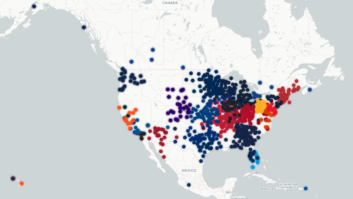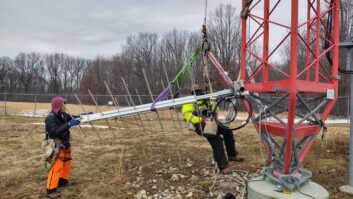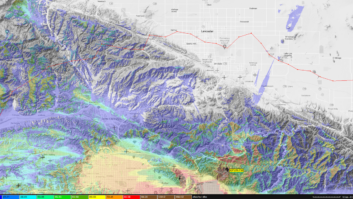AM Tuning Networks
Sep 1, 2012 1:35 AM, By Jeremy Ruck, PE
In January 2012 I looked at the venerable T network for impedance matching in AM antenna systems. Now I’ll discuss the L and Pi networks, and look at their use in antenna systems.
The L network is the simplest of the impedance transformation networks, and can be constructed with two reactive elements. Since it is the simplest of the transformation networks it essentially is the building block for the more complex T, Pi, and other types of networks. The simplicity in construction, however, also limits the usefulness of this network, and its ability to make transformations.

Two variations of an L network
Because capacitors and inductors are the flavors of reactive elements available, and it takes two elements to create the L network, there are two different general topologies available. One has the shunt leg on the load side of the network, while the other is the mirror image with the shunt on the generator side. Four different arrangements are possible within these two topologies depending on the combination of components utilized. Thus, eight different combinations would be possible for matching various impedances, although the four cases utilizing both a capacitor and an inductor are used are much more common. The shunt leg of the network will be located on the side with the greater impedance.
Not a simple transformation
It should be noted that an L network cannot be used to transform between two impedances where the resistance values are identical. Intuitively this should make sense as such a transformation can easily be accomplished through the use of a series inductor or capacitor depending on the direction you need to move the reactance. Inductors in series will add positive reactance, while a capacitor will take things the other direction adding negative reactance. If control of phase over such a transformation is required, then a T, Pi, or some other flavor of network must be utilized.
The Q of the network, which relates to the bandwidth, is determined by the ratio of the impedances to be transformed. This quantity, which cannot be independently selected by the network designer, is low for small transformations, and grows with the range of the desired transformation. So shifting high impedances down to standard transmission line values may result in higher than desired reflected power, and by extension VSWR, within the spectrum of a particular signal.
– continued on page 2
AM Tuning Networks
Sep 1, 2012 1:35 AM, By Jeremy Ruck, PE
Because the math can get a little hairy in complex impedance situations, we will take a quick look at an example matching two pure resistances. Let us assume our desired transformation is from a 50OMEGA; transmission line to a 100OMEGA; resistive load at 1000kHz. We know right off the bat that the shunt leg of the network will be on the load side, and since we will limit ourselves to networks with both a capacitor and inductor, there are two possible solutions. The first step is to determine the Q:

The first case has the capacitor in the shunt leg and the inductor in series. The values for the components are as follows:


Moving the inductor to the shunt leg and the capacitor to the series leg results in the following:


When using these equations, it is important to keep track of the decimal places. The frequency denoted by “f” is in terms of hertz, and the derived capacitance will be in farads, and inductance in henries. Because 1000kHz is 1MHz, and our desired component values are microhenries or microfarads, we can simplify the terms somewhat.

In this case the solution with the smaller inductor is probably the more cost effective solution; however, in a pinch you can use what is on the shelf. Note also that if you add an element in series on the load side of the network, you have created a T network. This additional element should be used to reduce the complex impedance to a pure resistance, then employ the above equations to make a match. Thus, with some components on the shelf, you could easily construct a matching network to return a non-directional AM station to air in a crisis.
– continued on page 3
AM Tuning Networks
Sep 1, 2012 1:35 AM, By Jeremy Ruck, PE
Easy as pi
The other network I will discuss is the Pi network. Now that the basic L network is easily visualized, it can be seen that a Pi network is really nothing more than two L networks stacked together. While the T network is two L networks stacked where the shunt legs are next to each other, the Pi network can be thought of the combination where the shunt networks are opposite each other.
As a consequence of these arrangements, an “intermediate” impedance at the center of the network is mathematically created. This value is a virtual quantity; however, it is usually adjusted in order to meet a desired Q value, and by extension, bandwidth across the network. Note that in the Pi network this virtual impedance will be lower than either the generator or load impedance because the shunt legs of the two L networks are opposite each other. The reverse is true for the T network.
The math for the Pi network becomes a little messier as trigonometric functions are introduced. The existence of the trigonometric functions gives rise to the control of the phase shift across the network. Equations for the various legs of a Pi network for a purely resistive transformation become the following where “A” is the shunt leg at the generator side, “B” the shunt leg at the load side, and “C” the series element between the two:



The beta term introduced in these equations is the phase shift desired across the network, and is in terms of radians, not degrees. Converting from degrees to radians is accomplished by multiplying by the value of Pi, and then dividing by 180. Note also that these equations will break down if the sine of beta is zero. This occurs in cases where the phase shift would be zero degrees or plus or minus 180 degrees.
The choice of matching networks varies as much as the ranges of impedances over which transformations can be made. Not only can the basic L network be expanded into the T or Pi, but other exotic combinations as well through various methods of cascading. Each of the designs has their advantages and drawbacks including bandwidth considerations, cost, currents and voltages, and dc continuity, to name a few. In the end, though, even the greenest of broadcast engineers can become proficient enough with simple L, and by extension T networks, to restore an AM station to operation until additional help arrives. That is something that management will definitely appreciate.
Ruck is the principal engineer of Jeremy Ruck and Associates, Canton, IL.
Understanding Tee Networks
The tee network seems almost magical as it has the ability to transform between almost any two complex impedances using only reactive elements….
September 2012
ESPN Radio broadcasts the All Star Game, the latest in program distribution, portable PAs, and Field Reports on Adobe Audition CS6 and the RDL HR-MCP2….







